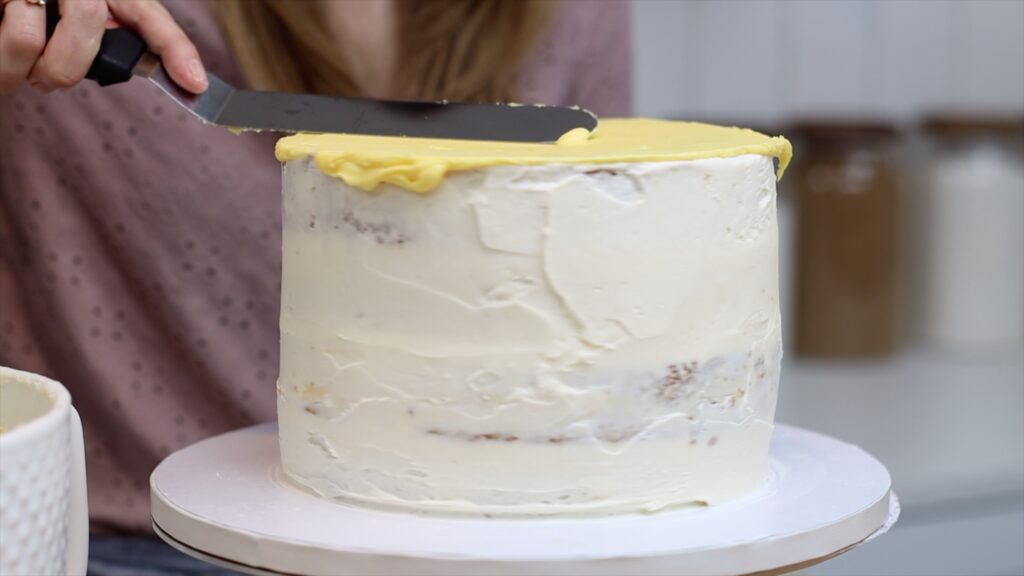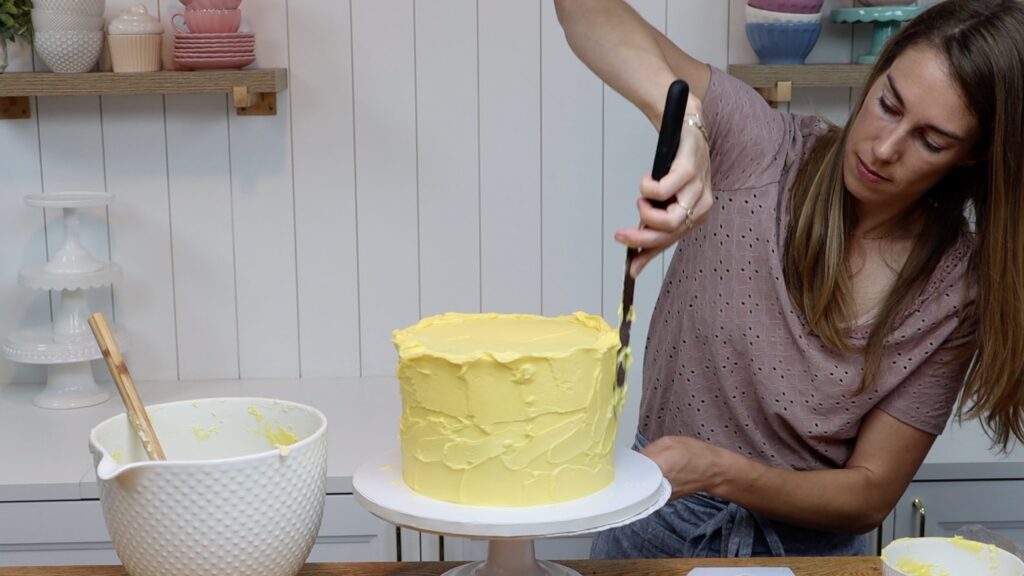
In this tutorial I'll show you how to frost a cake with perfectly smooth buttercream or any other frosting.
The secrets for how to frost a cake with perfectly smooth frosting are:
In Part 1 I showed you how to assemble layer cakes and in Part 2 why and how to crumb coat a cake. Go back to those tutorials for the first 'secret' and in this tutorial I'll cover the second and third.
Let's start with buttercream consistency. I like to use gel colours because they're more concentrated than liquid colours so they won't make the buttercream watery. As you mix the colours in you'll notice a lot about the consistency. It's too stiff if it's difficult to stir and it tears as you stir, breaking apart from itself and creating air pockets. You'll see lots of little lines of texture within the buttercream if it's thick and stiff. This buttercream is too stiff:

You can thin out buttercream by adding milk just a spoonful at a time. The other option is to scoop out a third of the buttercream and put it into a microwave safe bowl . Then microwave this for just 10 seconds. It's going to be very runny and melted and when you pour that into your buttercream it will thin out the thick stiff buttercream. The two consistencies will mix together to make a silky smooth buttercream, perfect for frosting a cake. Stirring it will also knock out any air bubbles in the buttercream. Can you see how much smoother this is than it was before?

Even with the perfect consistency, you won't get smooth frosting without the right technique. For this you'll need an
Start by spooning some buttercream onto the top of your cake. The crumb coat should have set while chilling in the fridge for at least 30 minutes first. Spread the frosting to cover the top of the cake and you want it to stick out over the sides as well. That will help you get really nice sharp angles later. Hold your

Then whisk the spatula away and scoop up more buttercream and spread it onto the side of the cake. I like to start at the top of the sides, spreading from side to side. At this point you're just covering the whole cake so that you can't see the crumb coat anywhere. Don't worry about how smooth this frosting is yet. However, you're aiming for an even thickness so if the frosting seems thinner in some parts, add more there now.
If your frosting is the right consistency it will transfer easily from your spatula onto the crumb coat. Your spatula will glide over it as you spread it, leaving a smooth surface behind. You won't see lots of tears or air bubbles or texture.

Go all the way to the bottom of the cake, covering up the crumb coat down to the cake board. Once it's all covered up, check the evenness of this frosting. On my cake the frosting looks thicker at the bottom so I'm spreading more around the top of the cake.
Push diagonally upwards to make the frosting stick up above the top edge of the cake. This lip or wall is important so that you can get sharp angles from the sides to the top later.
Now switch to your cake comb. Reach as far around as you can with your left hand for a really long spin on your

After scraping around the cake two or three times with your cake comb, you'll see where the frosting is thinner. Spread more frosting over those parts and any little indents, too. Scrape around the cake again to take off the excess and leave a smooth surface behind. Do these touch-ups as many times as you need to, spreading on more frosting to fill in any shallow areas and then scraping around the cake to smooth the frosting.

Now let me show you why I like to use a metal cake comb as well as this plastic one. The plastic comb is quick to use and I like the lightweight feel and flexibility. But it gets dinged along the edge easily by knocking or dropping it and those bumps drag along the frosting and leave trails behind.
If you're wondering how to frost a cake with a metal cake comb, here are the details. After getting the frosting fairly smooth, heat the edge of a metal cake comb. You can do this by running it under hot water or dipping it into a bowl or tray of hot water. The method I like best is to use a torch to heat it!

The edge of a metal cake comb doesn't get damaged as easily as plastic, so you'll get smoother frosting with it. By heating it, as you scrape around the cake it melts the very outer layer of frosting and drags it around the cake to fill in any imperfections. This leaves a super smooth surface on the frosting.

When the sides are smooth, it's time to tidy up the top edge, where the frosting sticks up above the cake. I use a long

Look what happens if you don't spread your frosting high enough. There are gaps in the frosting where it's thinner or shallower, which will become indents in the top edge. Spread more buttercream onto the indents on top and on the side of the cake and then scrape around the cake again with your cake comb. You'll smooth this touchup frosting so that the sides are straight. Swipe sideways with your

When you finish, go around the cake again and swipe wherever the frosting is higher. This will make the top edge straight and level all the way around the cake.
For super smooth frosting on a cake there are three tricks. First, the cake needs to be assembled, crumb coated and chilled correctly. I showed how to do those steps in the previous two tutorial in this series: how to make layer cakes and how to crumb coat a cake. Second, the buttercream needs to be the perfect consistency and third, you need to have the right technique.
If you have any questions, ask me in the comments! What comes next, after frosting the cake? You decorate it! To learn hundreds of cake decorating techniques and designs, visit my cake school.
You can also watch a video of this tutorial on how to frost a cake:
